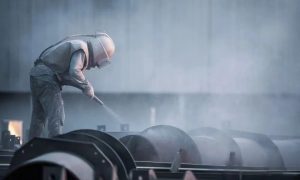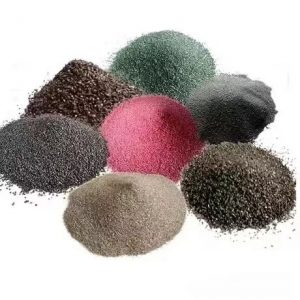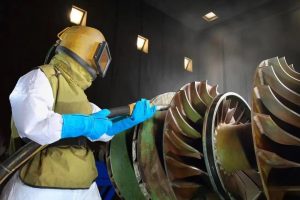Home / News & Blog / Abrasive Blog / Sandblasting Abrasive Industry Development Analysis Report

1. The Abrasive Industry Under the Macro Policy Framework
Under the macro background of global and Chinese manufacturing transformation and upgrading, environmental protection policy promotion, and the rise of emerging industries, the sandblasting abrasive industry is facing unprecedented development opportunities and challenges. The government’s support policies for the manufacturing industry, especially the guidance on green manufacturing and sustainable development, have had a profound impact on the sandblasting abrasive industry. With the improvement of global awareness of environmental protection, governments of various countries have introduced a series of environmental protection policies, which have had a profound impact on the development of the abrasive industry. The government encourages the abrasive industry to adopt environmentally friendly materials and production processes, reduce pollution emissions, and achieve green production. Some regions have even set strict limits on pollution emissions, forcing companies to upgrade technology and transform equipment. At the same time, promotes the recycling of resources and encourages the abrasive industry to recycle and reuse waste to reduce resource waste and environmental pollution.
To promote the healthy development of the abrasives industry, the government has also introduced a series of industrial policies, including: the government has set strict industry access standards, and requiring abrasive companies to have certain technical strength, production scale, and environmental protection capabilities before entering the market. This helps to improve the level and competitiveness of the entire industry. The government encourages the abrasives industry to carry out technological innovation, provides policy support such as R&D funds and tax incentives, and promotes the industry to develop in the direction of high-end and intelligentization. Through policy guidance, the abrasives industry is promoted to adjust its industrial structure, optimize resource allocation, eliminate backward production capacity, and enhance the overall competitiveness of the industry.

2. Industry Development in 2024 And Future Development Prospects Forecast
According to market research data, the sandblasting abrasive industry will continue to maintain steady growth in 2024. Taking non-metallic sandblasting abrasives as an example, its market size is constantly expanding and is expected to maintain a stable compound annual growth rate in the next few years. The global non-metallic sandblasting abrasive market size is approximately US$5.72 billion in 2023 and is expected to reach US$7.88 billion in 2030, with a compound annual growth rate (CAGR) of 4.4% from 2023 to 2030. The global sandblasting service revenue was approximately US$210.9 million in 2023 and is expected to reach US$317.8 million in 2030, with a compound annual growth rate (CAGR) of 6.0% from 2023 to 2030.
Specifically for the Chinese market, the non-metallic sandblasting abrasive industry has encountered challenges in 2024, but it still maintains growth in market size and sales. China’s non-metallic sandblasting abrasive market has accounted for 35.04% of the global market share in 2023, and the compound growth rate of the Chinese market is expected to remain at around 2.71% in the next six years. On the other hand, the demand for sandblasting machines in China is expected to reach 18,000 units in 2024, with a total output value exceeding RMB 6 billion; by 2030, this figure will increase to 30,000 units and RMB 15 billion respectively. This makes us full of confidence in the future development of the sandblasting abrasive industry.
3. The Impact of International Dynamics on the Abrasives Market
Undeniably, the global economy in 2024 is expected to feature low growth and moderate inflation, impacting the demand for abrasive blasting media and raw material prices, thereby increasing operational pressure on businesses. Sluggish international trade growth and persistently weak global trade may affect China’s exports of abrasive blasting media and the supply of imported raw materials.
With the global industrial chain undergoing accelerated restructuring, China must expedite its economic transformation and enhance the technological level and competitiveness of the abrasive blasting media industry to effectively address international market competition.

1. Economic Structure and Industrial Chain Layout
In terms of economic structure and industrial chain layout in 2024, China’s sandblasting abrasive industry is affected by the continuous decline in real estate investment and the slowdown in infrastructure investment, and the demand for sandblasting abrasives is relatively weak. The existing sand and gravel production lines can meet market demand, but the new production lines have increased the risk of overcapacity, resulting in high corporate inventory. This imbalance between supply and demand has caused the price of sandblasting abrasives to enter a downward range, and the profit space of enterprises has been compressed.
In this case, sandblasting abrasive companies have stepped up efforts to promote the coordinated development of upstream and downstream of the industrial chain, expanding the application of sandblasting abrasives in metal processing, marine engineering, automobile manufacturing, and other fields.
2. Market Application Scale and Future Trends
The application proportion of sandblasting abrasives in various industries varies depending on the specific market and time, which can be summarized as follows: Sandblasting abrasives are used in the metal processing industry with a high proportion of about 32%, mainly used for cleaning and strengthening metal surfaces, and pre-processing, etc. The demand for sandblasting abrasives in the fields of marine engineering and aerospace is also significant, accounting for about 30% in total, and is used for surface treatment and maintenance of ships, aircraft, and other equipment. The automotive industry is one of the important application areas of sandblasting abrasives, accounting for about 22%, and is mainly used for cleaning, rust removal, and surface treatment of automotive parts. In addition, sandblasting abrasives are also widely used in many industries such as construction, electronics, ceramics, glass, etc.
Metal Processing Industry: With the recovery of the manufacturing industry and increasing demands for material processing precision, the demand for abrasive blasting media in the metal processing sector will continue to grow. The market will increasingly focus on improving blasting efficiency, reducing environmental pollution, and developing new types of blasting media to meet diverse needs. Strict environmental regulations and occupational health and safety standards will drive the abrasive blasting media industry to focus on eco-friendly solutions, ensuring compliance and continuous improvement.
Marine Engineering and Aerospace Industry: Abrasive blasting media accounts for about 30% of the application in the marine engineering and aerospace sectors, indicating a significant demand for abrasive blasting media in these industries.
In the marine engineering sector, with continuous technological advancements, the market will drive ongoing innovations and upgrades in abrasive blasting media to improve operational efficiency and processing quality, meeting the demand for efficient and precise surface treatment in marine projects. Environmental requirements will push the abrasive blasting media toward greener, more eco-friendly solutions, such as the development of environmentally friendly abrasive materials. The application of intelligent technologies will further demand increased precision and efficiency of abrasive blasting media in marine engineering, such as automated control systems and remote monitoring.
In the aerospace sector, the focus will be on how abrasive blasting media can improve work efficiency and processing quality, while also meeting stricter environmental requirements and promoting green development. Abrasive blasting media will need to adapt to the processing needs of high-performance materials, such as high-temperature alloys and titanium alloys, ensuring effective treatment. Additionally, to meet the specific needs of the aerospace industry, abrasive blasting media will require more customized services, such as the selection of specific materials and particle sizes.
Automotive Manufacturing Industry: The automotive industry is one of the main application areas for abrasive blasting media. In 2022, the total revenue of the industry reached $240 million, demonstrating a high demand. It is expected that by 2029, the related revenue for abrasive blasting media in the automotive industry will reach $390 million. In the automotive manufacturing sector, the focus should be on integrating advanced technologies such as automation, robotics, the Internet of Things (IoT), and artificial intelligence to improve equipment precision and productivity, meeting the ever-changing customer demands.
The sandblasting abrasive industry faces many opportunities and challenges. In terms of opportunities, with the recovery of the manufacturing industry and the rise of high-end manufacturing, the market demand for sandblasting abrasives continues to grow, especially in the fields of aerospace, marine engineering, etc., where the application prospects are broad. At the same time, the improvement of environmental awareness has prompted the industry to develop in a green and environmentally friendly direction, providing market opportunities for innovative environmentally friendly sandblasting abrasives.
However, the industry also faces challenges, such as fluctuations in raw material prices, stricter environmental regulations, and uncertainty in the global economic environment. In addition, increasingly fierce market competition requires companies to continuously improve their competitiveness and strengthen technological innovation and R&D capabilities.
Looking ahead, the abrasive blasting media industry is expected to maintain steady growth, with technological innovation and environmental requirements becoming key drivers of industry development. Companies need to actively respond to challenges, seize market opportunities, and gain a competitive edge through technological innovation and high-quality services to achieve sustainable development.